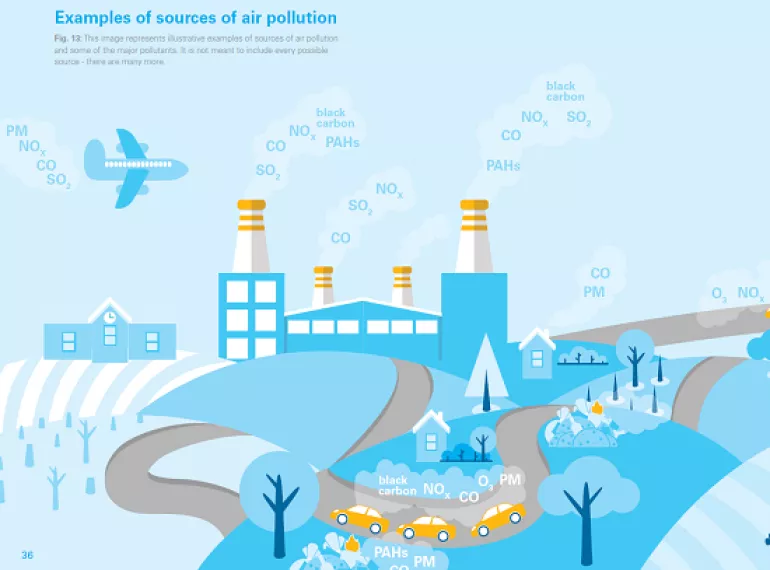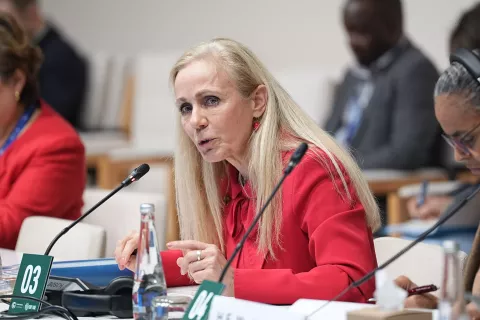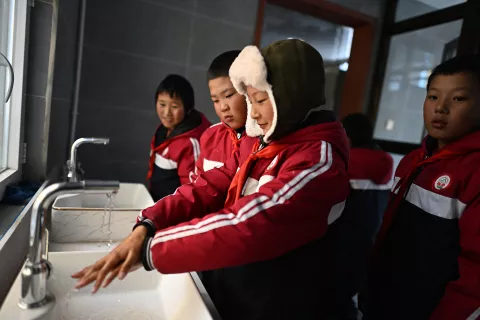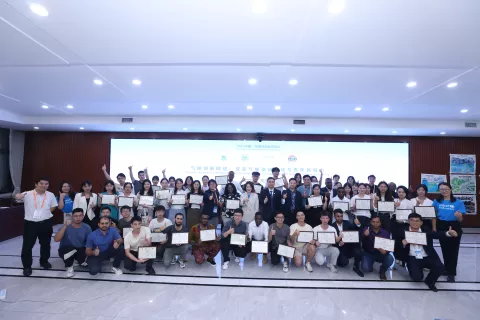Pollution: 300 million children breathing toxic air - UNICEF report
UN Children's Fund calls for urgent action at upcoming COP 22

- Available in:
- 中文
- English
NEW YORK/BEIJING, 31 October 2016 – Almost one in seven of the world's children, 300 million, live in areas with the most toxic levels of outdoor air pollution – six or more times higher than international guidelines – reveals a new UNICEF report.
Clear the Air for Children uses satellite imagery to show for the first time how many children are exposed to outdoor pollution that exceeds global guidelines set by the World Health Organization (WHO), and where they live across the globe.
The findings come a week ahead of the COP 22 in Marrakesh, Morocco, where UNICEF is calling on world leaders to take urgent action to cut air pollution in their countries.
"Air pollution is a major contributing factor in the deaths of around 600,000 children under five every year – and it threatens the lives and futures of millions more every day,” said UNICEF Executive Director Anthony Lake. “Pollutants don't only harm children's developing lungs – they can actually cross the blood-brain barrier and permanently damage their developing brains – and, thus, their futures. No society can afford to ignore air pollution."
The satellite imagery confirms that around 2 billion children live in areas where outdoor air pollution, caused by factors such as vehicle emissions, heavy use of fossil fuels, dust and burning of waste, exceeds minimum air quality guidelines set by the World Health Organization. South Asia has the largest number of children living in these areas, at 620 million, with Africa following at 520 million children. The East Asia and Pacific region has 450 million children living in areas that exceed guideline limits.
The study also examines the heavy toll of indoor pollution, commonly caused by use of fuels like coal and wood for cooking and heating, which mostly affects children in low-income, rural areas.
Together, outdoor and indoor air pollution are directly linked to pneumonia and other respiratory diseases that account for almost one in 10 under-five deaths, making air pollution one of the leading dangers to children's health.
Children are more susceptible than adults to both indoor and outdoor air pollution as their lungs, brains and immune systems are still developing and their respiratory tracks are more permeable. Young children also breathe faster than adults, and take in more air relative to their body weight. The most disadvantaged, who already tend to have poorer health and inadequate access to health services, are the most vulnerable to the illnesses caused by polluted air.
UNICEF is asking world leaders attending COP 22 to take four urgent steps in their countries to protect children from air pollution.
- Reduce pollution: All countries should work to meet WHO global air quality guidelines to enhance the safety and wellbeing of children. To achieve this, governments should adopt such measures as cutting back on fossil fuel combustion and investing in energy efficiency and renewable energy sources.
- Increase children's access to healthcare: Investing in children's overall healthcare – including immunisation campaigns nd improving knowledge, community management and numbers seeking care for pneumonia (a leading killer of children under five) - will improve their resilience to air pollution and their ability to recover from diseases and conditions linked to it.
- Minimize children's exposure: Sources of pollution such as factories should not be located within the vicinity of schools and playgrounds. Better waste management can reduce the amount of waste that is burned within communities. Cleaner cookstoves can help improve air quality within homes. Reducing air pollution overall can help lower children's exposure.
- Monitor air pollution: Better monitoring has been proven to help children, youth, families and communities to reduce their exposure to air pollution, become more informed about its causes, and advocate for changes that make the air safer to breathe.
"We protect our children when we protect the quality of our air. Both are central to our future," Lake said.
UNICEF is advocating for lower levels of air pollution, while also working on the ground to protect children from its effects. For example, the children's organisation backs the development, distribution and use of cleaner cookstoves in Bangladesh, Zimbabwe and other countries, and works through some of its country programmes to reduce the impact of outdoor air pollution on children's health. It also supports programmes to increase children's access to quality healthcare and to vaccinate them against conditions like pneumonia.
UNICEF commends the Government of China for the steps they have taken to address hazardous air pollution; putting in place measurement systems to quantify the problem, implementing rigorous emissions standards, and focusing on the most polluting industries. Targets set in the 13th five-year plan, commitment to the Sustainable Development Goals and ratification of the Paris climate agreement are all steps forward to ensuring a greener and healthier China.
UNICEF China is collaborating with the government counterpart to study the effects of environmental health on children and will support the development of a Child Environmental Health Action Plan as part of the National Environmental Health Action Plan. UNICEF is also engaged in activities to educate youth, raise awareness about climate change and empower children to be future leaders in tackling climate change and environmental issues.
"More needs to be done to protect children from the effects of air pollution, not only by Governments, but by all of us. While reducing outdoor air pollution is the longer term goal, immediate steps can be taken to reduce indoor air pollution. Switching to clean fuels, ensuring good ventilation, building energy efficient homes and schools, and stopping all cigarette smoking indoors are examples. Parents can also take steps to protect their children against the most harmful effects of air pollution by building resilience in their children, thus tackling the risk factors for air pollution related disease, these include reducing any exposure to tobacco smoke, avoiding undernutrition, and exclusively breastfeeding their babies to six months of age. Coverage of pneumococcal vaccination and treatment to reduce the incidence of pneumonia is also a key action that saves young lives," said Rana Flowers, UNICEF Representative to China.
Notes to editors:
Photos and video are available for download here: http://uni.cf/2dD80BZ
Interviews are available.
About UNICEF
UNICEF works in some of the world's toughest places, to reach the world's most disadvantaged children. Across 190 countries and territories, we work for every child, everywhere, to build a better world for everyone. For more information about UNICEF and its work for children visit www.unicef.org.
| Visit UNICEF China website: www.unicef.cn Follow us on Sina Weibo: http://weibo.com/unicefchina Tencent Weibo: http://t.qq.com/unicef Wechat: unicefchina |




